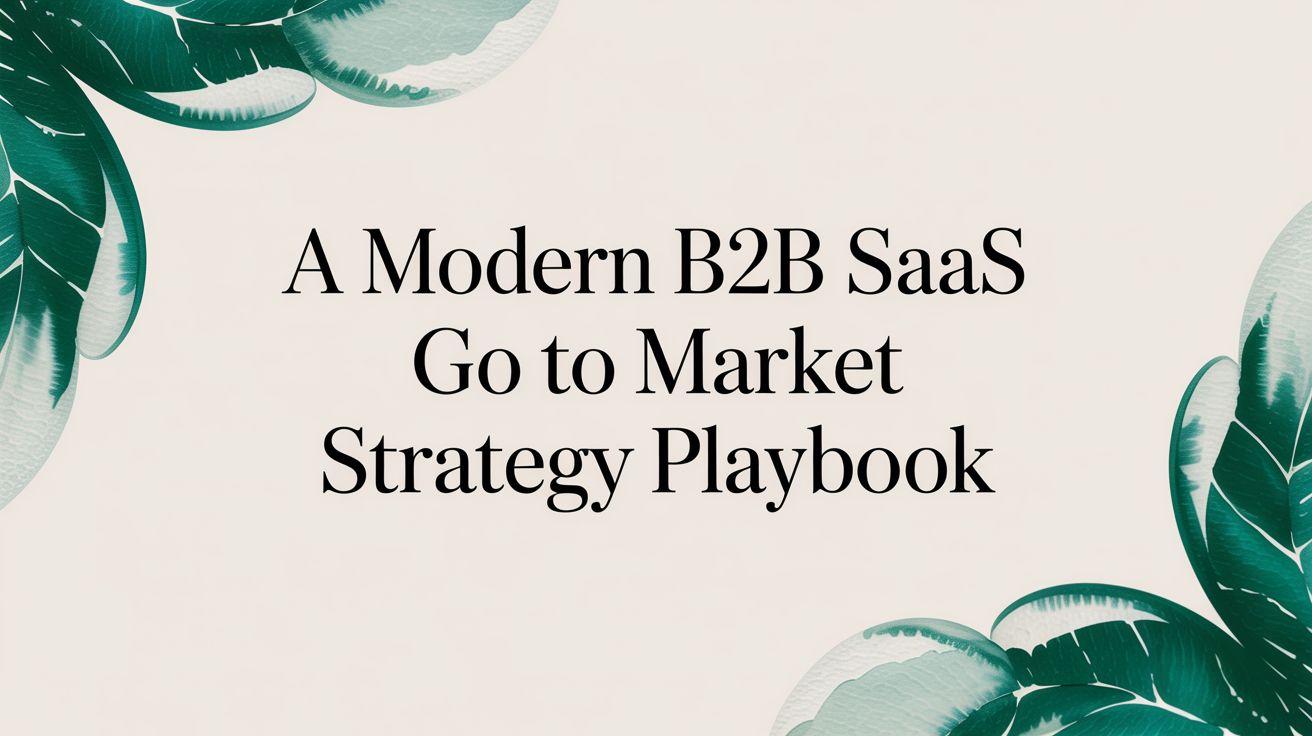A Modern B2B SaaS Go To Market Strategy Playbook
November 12, 2025

A solid B2B SaaS go-to-market strategy isn't just a document; it's the detailed game plan for how you'll launch a new product or break into a new market. It’s what gets your product, marketing, sales, and customer success teams all rowing in the same direction to bring in—and keep—customers efficiently.
Think of it as the essential blueprint that makes sure every single action has a purpose, from figuring out who your ideal customer is all the way to tracking revenue growth.
Your Blueprint for Sustainable SaaS Growth
Before you write a single line of code or design that first sales deck, you have to get a real handle on the opportunity in front of you. This goes way beyond just looking at market size. It's about deeply understanding the forces at play—like the massive shift to remote collaboration or the rise of operational AI—that create real openings for new tools.
Having a deliberate go-to-market strategy is what separates a product that just exists from a business that actually thrives.
This way of thinking forces you to shift your perspective. You're not just building a cool tool; you're engineering a predictable revenue machine. Getting this right from the start is the foundation for every single tactical decision you'll make later on.
Why a GTM Strategy Matters Now More Than Ever
The B2B SaaS market is absolutely exploding. Projections show the market is on track to hit $344 billion by 2027. The United States alone is expected to make up about $225 billion of that market by 2025. This incredible growth is being fueled by big leaps in cloud computing, data analytics, and AI, which are making it possible to deliver better customer experiences at scale.
All this growth creates a ton of opportunity, but it also means the market is incredibly noisy. Without a crystal-clear plan, even the most brilliant products can get completely lost in the shuffle.
A go-to-market strategy isn't a static document you create once and forget about; it’s a living blueprint for generating revenue. It forces you to answer the tough questions upfront: Who are we actually selling to? Why are they going to buy from us? And how are we going to reach them? Answering these questions builds the foundation for scalable success.
The flow chart below gives you a high-level look at how this blueprint comes together, starting with market analysis, moving into strategic planning, and ending with measurable revenue outcomes.

This visual really drives home the point that success isn't a single event—it's a sequence of deliberate, connected actions. Each stage builds on the one before it, turning your understanding of the market into a concrete plan for growth.
The Core Components of Your GTM Blueprint
A winning GTM strategy gets multiple parts of your organization working in harmony. It's the connective tissue that aligns everyone toward a single, shared goal. Here are the key elements you'll need to nail down:
- Market Definition: Pinpointing your target audience and crafting a detailed Ideal Customer Profile (ICP). Who are they, really?
- Positioning and Messaging: Nailing a value proposition that genuinely resonates with your ICP and makes them pay attention.
- Pricing and Packaging: Designing a model that perfectly aligns the value you deliver with what you charge.
- Acquisition Channels: Choosing the most effective and efficient ways to actually get in front of your customers.
- Sales Motion: Defining the exact process your sales team will use to turn interested prospects into happy customers.
If you're looking for a deeper dive into how to build out these foundational pieces, this B2B go-to-market strategy framework is a fantastic resource. It provides a detailed structure for tackling each of these critical components.
Pinpointing Your Ideal Customer Profile
A winning GTM strategy lives and dies by one thing: an almost obsessive focus on who you’re selling to. It’s not enough to have a general idea. You need a razor-sharp understanding of the exact companies—and the people inside them—who are desperate for your solution.
Getting this right is the foundation for everything that follows. It dictates your messaging, your sales motion, and even your product roadmap. The whole point is to uncover their real-world pain points, their urgent buying triggers, and the specific business outcomes they’re trying to hit.
When you nail this, your value proposition feels less like marketing copy and more like you’re reading their minds.
Moving Beyond Basic Firmographics
First things first: you need to define your Ideal Customer Profile (ICP). An ICP is a detailed spec sheet for the perfect-fit company for your product. I’m not talking about just any company that could use it, but the one that will get the most value, stick around the longest, and become your most profitable champion.
Think of it as creating a "most wanted" poster for your dream client. What makes them tick?
- Industry or Vertical: Forget broad categories. A solution for "technology companies" is way too generic. A solution for "Series B FinTechs struggling with compliance reporting"? Now you’re talking. Get specific.
- Company Size: This could be annual revenue (like $10M - $50M ARR) or employee count (e.g., 50-250 employees). This detail shapes who you talk to and the scale of problems they’re facing.
- Geography: Are there regional regulations or market dynamics that make your solution a no-brainer in North America but a tough sell in the EU?
- Technology Stack: What other software are they already using? A company running on Salesforce might be a perfect fit for your new integration, while one on a custom-built CRM would be a dead end.
This data-driven approach stops you from wasting time and money trying to sell to everyone. Instead, you focus your firepower where it will have the biggest impact.
The core of a strong ICP isn't just about who you could sell to, but who you should sell to. It's the intersection of where you provide the most value and where you can win most efficiently. Getting this right prevents months of wasted effort chasing deals that were never going to close.
Building Your Buyer Personas
Once your ICP tells you which companies to target, buyer personas bring the actual people inside those companies to life. You aren't selling to a logo on a building; you’re selling to individuals with their own unique jobs, pressures, and goals.
For any significant B2B purchase, you’ll run into a cast of characters. To really get a handle on this, you need to understand what makes each of them tick. For a deeper dive, check out this excellent guide on how to create buyer personas.
Let’s say you sell project management software for engineering teams. You're going to have a few key people to convince:
- The Economic Buyer (VP of Engineering): This is the person signing the check. They live and die by ROI, team productivity metrics, and anything that reduces project delays hitting the bottom line. Their main question is always, "How will this software make my department more efficient and save us money?"
- The Champion (Engineering Manager): This is the person feeling the pain most acutely. They’re tearing their hair out over missed deadlines and have zero visibility into project progress. They will be your internal advocate, fighting for your solution if they truly believe it solves their daily headaches.
- The End User (Software Engineer): This is the person who will be in your software every single day. They care about usability, how well it integrates with their existing tools (like GitHub), and whether it actually makes their job easier or just adds more friction.
Understanding these distinct roles is everything. When you build out detailed personas, you can tailor your messaging and sales approach to resonate with each one.
If you really want to go deep on this, we've put together a complete guide on using buyer personas to accelerate B2B marketing and sales that will walk you through the entire process.
Designing Your Pricing and Packaging Model
Pricing is one of the most powerful, yet often misunderstood, tools in your entire go-to-market strategy. Get it right, and you create a frictionless path to adoption and growth.
Get it wrong? Even the best product will struggle to gain traction. The goal is to design a model that feels like an obvious win for your customers while building a sustainable revenue stream for your business.

This isn’t about just picking a number out of thin air. It's a strategic decision that directly influences who you sell to and how you sell to them, born from a deep understanding of the value you deliver.
Aligning Price with Value and Motion
The perfect pricing model is a direct reflection of your product's value metric—the core unit of value a customer receives. Is it the number of users, the volume of data processed, or the number of projects managed? Tying your price to this metric ensures that as your customers find more success with your product, your revenue grows right alongside theirs.
This alignment also dictates your primary sales motion. A low-priced, self-serve product naturally lends itself to a product-led growth (PLG) model, where the product itself is the main driver of acquisition. In contrast, a high-value, complex solution almost always requires a sales-led growth (SLG) motion, where a skilled sales team guides enterprise buyers through a consultative process.
The data backs this up. Top-performing B2B SaaS firms reach 1,000 subscribers in a median of just 11 months, while the average company takes about two years. The faster group often focuses on lower average selling prices, allowing them to fully embrace a PLG approach without introducing sales friction and achieve impressive 20% median growth rates in new business ARR. You can explore more data on how GTM strategies impact growth in this comprehensive SaaS report from ChartMogul.
Choosing the right pricing model is about matching your product's value and complexity to the most effective sales motion. The table below breaks down how these pieces fit together.
GTM Motion and Pricing Model Alignment
As you can see, there’s a clear relationship between how you charge and how you sell. A simple per-user model works well for PLG, while a high-touch, value-based sale demands a dedicated sales team.
Choosing the Right Pricing Structure
There is no single "best" pricing model; there's only the best model for your specific product, market, and ideal customer. Let's break down the most common structures you'll see in B2B SaaS today.
- Per-User Pricing: This is the classic model where you charge a flat fee for each person using the software. It’s simple for customers to understand and predictable for your financial forecasting. The downside? It can sometimes create a barrier to adoption within larger teams if the cost per seat feels too high.
- Tiered Pricing: This approach involves creating distinct packages (e.g., Basic, Pro, Enterprise) with escalating features and price points. Tiers are excellent for catering to different customer segments, from small businesses to large corporations, and create a clear upgrade path as a customer's needs grow.
- Usage-Based Pricing: Here, customers pay based on how much they use the product—think API calls, data storage, or transactions processed. This model perfectly aligns cost with value, making it an attractive option for customers who want to start small and scale their spending as their business grows.
- Value-Based Pricing: This is the most strategic but also the most difficult model to pull off. Pricing is determined not by your costs or features, but by the tangible business value or ROI your product delivers. It requires deep customer knowledge but can result in the highest revenue potential by far.
Your pricing page is more than just a list of prices; it’s a critical piece of your product marketing. It should clearly communicate the value of each package and guide the right customers to the right plan, making the decision to buy feel both easy and intelligent.
Packaging for Adoption and Expansion
Beyond the pricing model, how you package your features is crucial for driving both initial adoption and long-term expansion revenue. A well-designed packaging strategy acts as a silent salesperson, guiding users toward greater value.
For instance, a freemium or free trial offering is a powerful tool in a PLG motion. It lowers the barrier to entry, allowing users to experience your product's "aha!" moment firsthand. The key is to offer enough value in the free tier to get them hooked, while holding back more advanced features that a growing business will inevitably need and be willing to pay for.
Structuring your paid tiers should create natural expansion pathways. Place features that support collaboration, advanced security, or scalability in higher-priced plans. As a customer’s team grows or their needs become more complex, the decision to upgrade becomes a logical next step rather than a painful upsell.
Thinking through these elements is a critical exercise. To get a more detailed look at different models and how to implement them, check out our in-depth guide to developing a winning SaaS pricing strategy. Ultimately, your pricing and packaging should work together to tell a compelling story about the journey a customer will take with your product, from their first interaction to becoming a power user.
Building Your Demand Generation Engine
Once you have your Ideal Customer Profile locked in and your offer is razor-sharp, it's time to build the engine that brings qualified buyers to your doorstep. This isn't about casting a wide net and hoping for the best. It's about systematically lighting up the right channels to create a predictable flow of real opportunities.
Think of a well-oiled demand generation plan as the heart of your entire B2B SaaS go to market strategy. This is exactly where all that upfront work on your ICP starts to pay massive dividends. The channels that work well for a low-cost, product-led growth tool will be a total waste of money for a high-touch enterprise sale. Your job is to meet your ideal customers where they already are, looking for answers.
Prioritizing Your Acquisition Channels
The biggest mistake you can make here is trying to be everywhere at once. It's a recipe for burning cash and getting mediocre results. Instead, concentrate your firepower on a handful of channels that promise the highest potential return.
The real goal is to build a cohesive plan where each channel supports the others. It’s like a force multiplier, creating a powerful effect that drives consistent, sustainable growth.
Here’s a breakdown of the channels that consistently deliver for B2B SaaS and how to think about where to start:
Content Marketing & SEO: This is the long game, but it's arguably the most sustainable way to grow. By creating genuinely valuable content that solves your ICP's most pressing problems, you build authority and attract a steady stream of organic traffic. This is a must-have for any SaaS product with a research-heavy buying cycle—it catches buyers right when they're looking for solutions.
Targeted Paid Ads: Platforms like LinkedIn and hyper-targeted search ads are your snipers. They let you get your message directly in front of your ICP with surgical precision. This is the perfect channel for testing new messaging on the fly and driving immediate, focused traffic for specific campaigns, especially when your audience is dialed in.
Account-Based Marketing (ABM): If you're chasing high-value, enterprise-level clients, ABM isn't just nice to have; it's essential. ABM flips the traditional marketing funnel on its head, concentrating both sales and marketing resources on a hand-picked list of dream accounts. It's resource-intensive, for sure, but incredibly effective for complex sales with a whole committee of stakeholders.
Strategic Partnerships: Teaming up with non-competing companies that already serve your ICP can be a massive growth accelerant. This could look like co-marketing webinars, product integrations, or even reseller agreements. It's a powerful way to tap into an established, trusted audience and borrow credibility.
Your first channel mix should be a calculated bet, based entirely on your ICP’s behavior and your average deal size. Start with one or two primary channels, get really good at them, and then thoughtfully expand as you see the data roll in on what truly moves the needle.
Crafting a Cohesive Multi-Channel Plan
The magic really happens when you make these channels work together. A potential customer might first see your brand through a LinkedIn ad, later read a blog post they found on Google, and then sign up for a webinar you co-hosted with a trusted partner.
Each touchpoint builds on the last, naturally guiding them through their journey.
Let's say you're selling a compliance automation tool for FinTech companies. Your integrated plan might look something like this:
The Foundation (SEO & Content): First, you create a massive pillar page on "Navigating FinTech Compliance," supported by a cluster of blog posts on specific regulations. This foundational content starts attracting organic search traffic from your ICP as they research the problem.
The Activation (Paid Ads): Next, you run LinkedIn ad campaigns targeting "Heads of Compliance" at FinTech companies with 50-500 employees. These ads don't just push a demo; they drive traffic to a high-value Ebook that expands on the pillar page content, capturing leads.
The Acceleration (Partnerships): To seal the deal, you partner with a well-known FinTech law firm to host a webinar on upcoming regulatory changes. This move lets you tap into the firm's credibility and audience, generating a flood of high-quality, high-intent leads.
This integrated approach ensures you’re meeting prospects at every stage of their journey, building trust and recognition over time. For a deeper dive into building out these kinds of plays, our complete guide on B2B demand generation offers a more detailed framework.
Measuring Performance to Ensure ROI
Finally, a demand gen engine is useless without a dashboard. You have to track performance religiously to make sure every dollar and every hour you spend is actually contributing to growth. Don't get lost in vanity metrics like impressions or clicks; focus on what directly impacts revenue.
Start with a simple framework that connects your marketing actions to real business outcomes:
By keeping a close eye on these core metrics, you can make smart, informed decisions about where to double down and where to pull back. This data-driven approach is what transforms your demand generation from a bunch of disconnected tactics into a fine-tuned engine for predictable revenue.
Equipping Your Sales Team to Win
All your meticulous GTM planning—the ICP, the positioning, the pricing—it all comes to a head the moment a salesperson actually talks to a prospect. This is where the rubber meets the road. Arming your sales team with the right tools, knowledge, and processes isn't just helpful; it’s the critical step that turns a brilliant strategy into consistent revenue.
This is all about building a repeatable, scalable sales motion. Your team needs to move beyond just "winging it" on calls. They need a playbook that gives them the confidence and clarity to guide prospects from initial curiosity to a signed contract, every single time.

Building the Essential Sales Playbook
A modern sales playbook is the single source of truth for your entire sales organization. Think of it as a living resource that standardizes excellence, making sure every rep is equipped with the best messaging, tactics, and assets to win deals. Honestly, it’s a non-negotiable part of any B2B SaaS go-to-market strategy that works.
Here are the core assets your playbook absolutely must contain:
- Compelling Case Studies: Nothing sells like success. Give your team powerful stories of how existing customers crushed their biggest problems using your product. These can't be fluffy testimonials; they need to be detailed, focusing on the before-and-after with hard data and measurable ROI.
- Crisp Battle Cards: Your reps will inevitably go head-to-head with other solutions. Battle cards give them quick, scannable talking points on key differentiators, opponent weaknesses, and how to reposition your solution to play up its unique strengths.
- Effective Demo Scripts: A great demo is a story, not a feature tour. Your demo scripts should be frameworks that guide reps to connect your product's capabilities directly to the specific pain points a prospect shared during discovery.
- Objection Handling Guides: Prepare your team for the tough questions. Create a guide that lists common objections—“You’re too expensive,” or “We’re happy with our current tool”—and provides proven, thoughtful responses that reframe the conversation around value.
These assets are what transform your sales motion from an art into a science, driving consistent performance across the entire team.
Designing Your Sales Motion
Your sales motion is the specific, step-by-step process your team follows to move a deal forward. The right motion depends entirely on your product's complexity and price point. A high-touch, consultative process for a $100,000 enterprise deal looks vastly different from a fast, efficient process for a $100/month SMB tool.
For a high-touch sale, the process might involve multiple stages:
- Initial Discovery Call: Focused entirely on digging into the prospect's challenges and qualifying their fit.
- Tailored Product Demo: A customized walkthrough showing exactly how your solution solves their specific problems.
- Technical Deep Dive: A call with a sales engineer to tackle detailed questions and security concerns.
- Proposal & Negotiation: Presenting a formal proposal that clearly outlines the scope, ROI, and terms.
- Closing: Finalizing the contract and initiating the handoff to customer success.
Your sales process should be a mirror image of your ideal customer's buying journey. It’s not about forcing them through your funnel; it’s about guiding them through their decision-making process with expertise and insight at every step.
On the other hand, a more transactional, high-velocity sales motion for a simpler product might roll several of these steps into a single call. The key is to design a process that removes friction and builds momentum. To go deeper on this, explore our guide on building a high-performing B2B sales pipeline, which provides a structured approach to defining these crucial stages.
Ultimately, equipping your sales team is about translating your GTM strategy into daily action. By giving them a world-class playbook and a well-defined sales motion, you empower them to execute your vision with precision and turn your growth plans into reality.
Measuring What Matters for GTM Success
Your go-to-market strategy isn't a "set it and forget it" document. Think of it as a living plan that needs constant attention and data to steer your growth in the right direction. When you get this right, your GTM plan becomes a powerful feedback loop, driving continuous improvement.

The trick is to track the vital signs across both marketing and sales to get the full picture. Focusing on the right numbers helps you spot bottlenecks before they become major problems, uncover hidden opportunities, and make smart decisions with confidence.
Core GTM Performance Indicators
To kick things off, don't overwhelm yourself with data. Zero in on a handful of metrics that directly reflect the health of your customer acquisition engine. These are the numbers that tell the real story.
Customer Acquisition Cost (CAC): This is the bottom-line cost of your sales and marketing efforts to land one new customer. Keeping a close watch on CAC is essential to make sure your growth is actually profitable.
Lifetime Value (LTV): LTV is the total revenue you can realistically expect from a single customer over their entire journey with you. A healthy business model demands an LTV that's significantly higher than your CAC—no exceptions.
Pipeline Velocity: This metric tells you how quickly deals are moving through your sales funnel from initial contact to close. Increasing your pipeline velocity means you're closing deals faster and pulling revenue forward.
Your GTM dashboard shouldn't just be for reporting—it's your diagnostic tool. When a metric starts trending the wrong way, that's your cue to dig in, find the "why" behind the number, and take corrective action.
For B2B SaaS companies, the impact of a finely tuned GTM model is massive. An analysis of 446 companies found that those with self-serve revenue models saw a 25.9% higher conversion rate from free to paid plans. They also hit profitability nearly twice as often as their peers. You can dig into more performance benchmarks in this in-depth report on the state of B2B SaaS.
Getting a handle on these vital SaaS marketing metrics is the first step toward building a predictable growth engine.
Frequently Asked Questions
Navigating the complexities of a B2B SaaS go to market strategy is guaranteed to bring up some tough questions. Getting clear, straightforward answers is what separates a plan that just sits on a shelf from one that actually gets your team fired up and delivering results.
When Is the Right Time to Create a GTM Strategy?
Short answer: You should be building your go-to-market plan at the same time you’re building your product, not after it’s finished.
It's a classic—and costly—mistake to build a solution and only then start figuring out who might want to buy it. Running these two processes in parallel is a non-negotiable.
This approach ensures your product development is constantly being pressure-tested against market realities. It forces you to validate every assumption about your ideal customer, their real-world pain points, and what they’re truly willing to pay before you've sunk millions into engineering.
How Much Should We Budget for a GTM Launch?
There’s no magic number, but a smart way to start is by tying your budget directly to your Customer Acquisition Cost (CAC) and revenue targets. For early-stage B2B companies, CAC can be all over the map, ranging anywhere from $300 to $15,000 depending on how big and complex your target market is.
A disciplined approach involves dedicating a specific percentage of your projected first-year Annual Recurring Revenue (ARR) to the launch. This figure often falls between 15-25% for a focused, initial market entry, ensuring you have enough fuel to get off the ground without overspending before you've validated your model.
How Often Should We Revisit Our GTM Strategy?
Your GTM strategy should never be a static document collecting dust in a folder; it’s a living blueprint for your business. You should plan to formally review and adjust it every quarter, but your eyes need to be on your core KPIs every single week.
Any significant market shift, the emergence of a new direct opponent, or consistently missing your key metrics—these are all triggers for an immediate, deep-dive reassessment. This agile mindset is what allows you to pivot quickly, turning potential setbacks into new opportunities for growth.
Ready to build a B2B SaaS go-to-market strategy that wins deals and drives revenue? At Big Moves Marketing, I specialize in creating the positioning, sales tools, and launch plans that help founders secure early customers and build momentum. Let's build your go-to-market plan together.
%20-%20Alternate.svg)

%20-%20white.svg)